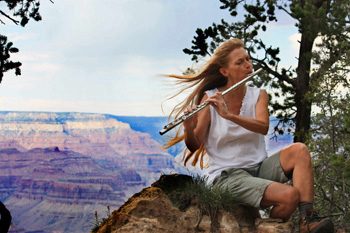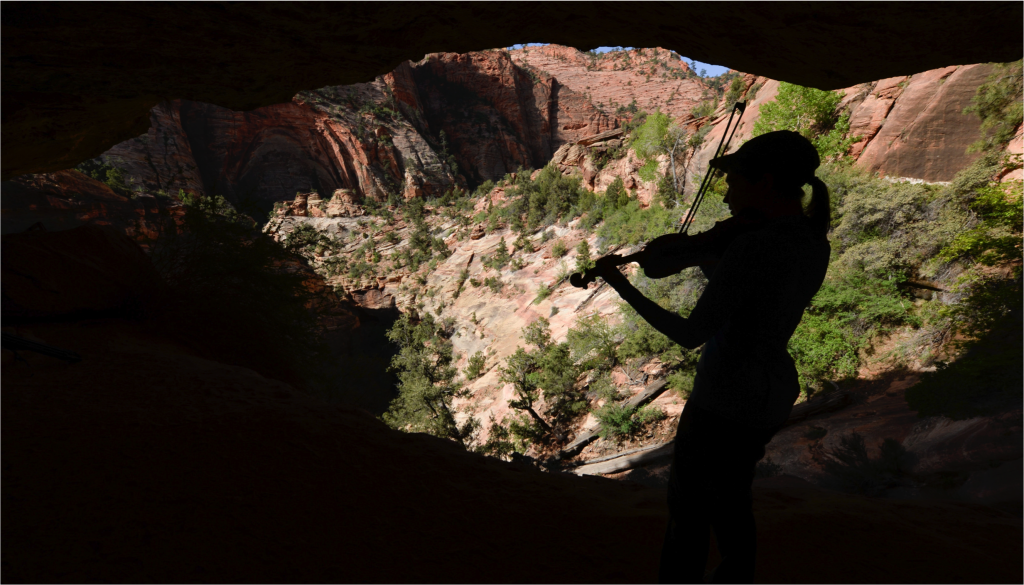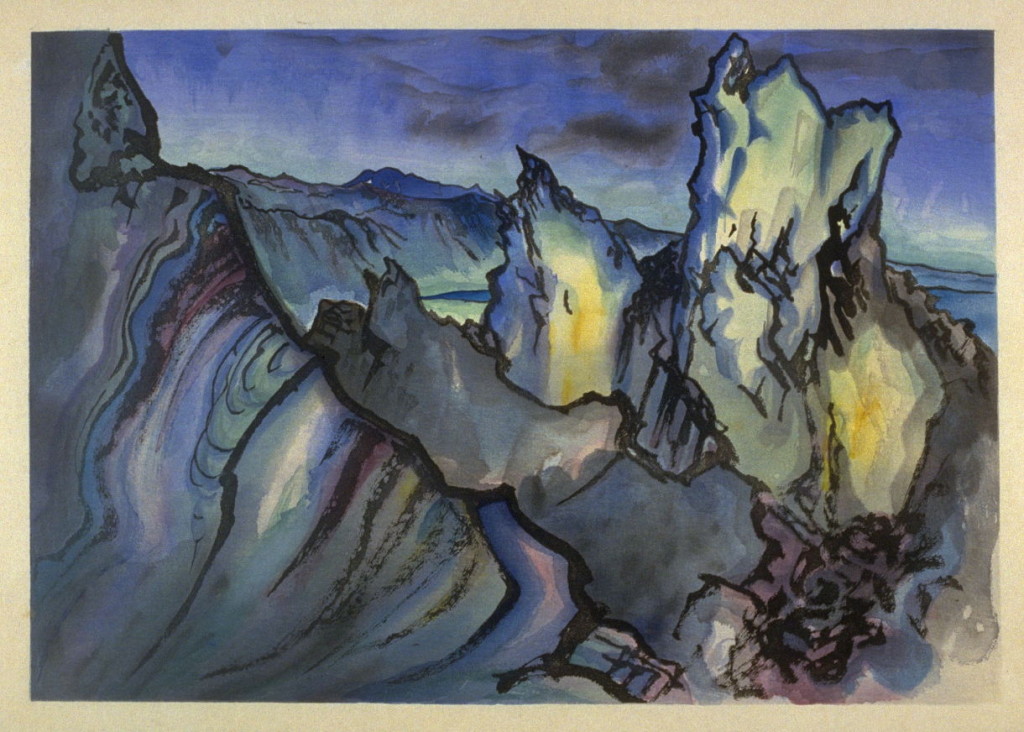
Linda Chase performs on the rim of the Grand Canyon, August 2012. Photo by Autumn Chase-Dempsey.
This Spring, the epic landscapes of Zion, Grand Canyon, and Yosemite will be brought to life in Boston. New Music of Our National Parks is a concert of new chamber music inspired by nature, honoring the national parks in the centennial year of the National Park Service. I’m delighted to be involved with this project, produced by Rachel Panitch in affiliation with the Landscape Music Composers Network.
The concert, which will take place on Friday, April 15, 2016 at 8:00pm on the monthly Advent Library Concert Series at The Church of the Advent in the heart of historic Beacon Hill, Boston (suggested donation is $10), brings together works by three members of the Composers Network—Rachel, Linda Chase, and myself—and features performances by Cardamom Quartet, vocalist Burcu Gulec, flutist Alicia Mielke, guitarist Devin Ulibarri, and the vibraphone/violins trio Thread Ensemble.
I’ve previously posted a brief announcement and a press release about the event. Below, I dig a bit deeper into the works featured on the program and explore how each of the composers drew inspiration from national parks.

Violinist/Composer Rachel Panitch in Zion National Park during 2014 Artist Residency, Photo: Francisco Kjolseth, Salt Lake Tribune.
Rachel Panitch: Zion National Park
Violinist and composer Rachel Panitch presents works she created as Artist-in-Residence at Zion National Park in Utah, including Impressions: Zion Canyon for string quartet, a selection of fiddle pieces performed with cellist Ariel Friedman, and structured improvisations performed with Thread Ensemble. These works are Panitch’s musical interpretations of Zion’s striking geological forms, as well as her experiences hiking through the park and interacting with visitors during her four-week residency.
I’ve previously interviewed Rachel about this residency and how her time in Zion affected her creative practice. Her work was influenced by listening to sounds in the park; starting each day with short improvisations; juggling work on multiple pieces simultaneously, combined from ideas she collected on hikes; and her conversations with visitors and park staff. Her musical ideas arose primarily from her impressions of the park’s “light, color, angles, textures, places, experiences, words, images, feelings.”
Linda Chase: Grand Canyon National Park
Flutist, composer, and poet Linda Chase’s residency at Grand Canyon National Park gave rise to the creation of two works featured on New Music of Our National Parks which, Linda explains, “speak of our responsibility to take care of the wilderness, to honor the natural world and to speak out against injustice.” Here’s an excerpt from Beyond Eternity:
During her residency, Linda “became aware of the uranium mining industry that continues to threaten the area. Decades of uranium mining in the region have permanently polluted surface and groundwater and threaten people’s lives, and plant and animal communities. Old mines are still reopening without updating the environmental impact. Radioactive dust from the uranium mine sites is a well-known contaminant but is hauled in tarpaulin-covered dump trucks, instead of requiring air-tight and water-proof containers that would prevent leakage.”
Linda’s response took the form of two works scored for voice and string quartet, which will be performed on April 15 by Burcu Gulec with Cardamom Quartet.
Beyond Eternity is a “song to the Grand Canyon.” Bell Tower, Linda writes, “was inspired by a Rainer Maria Rilke poem. Sometimes the violence, oppression and exploitation of people and the earth can cause a sense of hopeless and despair. Let This Darkness be a Bell Tower, speaks to me about not losing faith, by being the bell and listening to the earth.”

Chiura Obata, “Mono Crater, Sierra Nevada, California” (1930). Source: FAMSF.
Nell Shaw Cohen: Yosemite National Park
My own piece on the concert—Dai-Shizen (Great Nature), written for the flute and guitar duo of Alicia Mielke and Devin Ulibarri—looks at a national park through the eyes of a visual artist: Chiura Obata (1885-1975). It is my musical response to Obata’s journey through landscapes, as seen through his artworks, in three movements: California, Topaz, and Sunset. Here’s an excerpt from California:

Chiura Obata, “Evening Glow of Yosemite Waterfall, Yosemite National Park, California” (1930). Source: FAMSF.
Obata’s woodblock prints and watercolors from the 1920s and ’30s show some of the most extraordinary visual representations of Yosemite ever created, from El Capitan to Mono Lake. California was this Japanese-American artist’s greatest inspiration.
Obata and his family were then imprisoned for over year in internment camps during World War II, primarily in Topaz, Utah. Despite demeaning conditions, Obata strove to bring meaning into the lives of those around him. He founded an art school with his fellow internees and created stunning, emotionally charged watercolor paintings juxtaposing the dreary manmade structures of the prison camp against broad expanses of desert, mountains, and fiery sunsets.
In composing this piece, I was particularly inspired by Obata’s ability to follow his philosophy of dai-shizen (Great Nature)—nature as a source of artistic inspiration and spiritual harmony—throughout the best and worst moments of his life.
I hope you’ve enjoyed this preview of New Music of Our National Parks! For additional information about the concert and artist biographies, check out the press release and Advent Library Concert Series website.
Learn more about the artists and topics in this article:
- Rachel Panitch and Zion National Park (NPS website)
- Linda Chase and Grand Canyon National Park (NPS website)
- Nell Shaw Cohen and Yosemite National Park (NPS website)
- For more images of Chiura Obata’s artworks, visit Fine Arts Museums of San Francisco. To learn more about the artist, I recommend the following books: Obata’s Yosemite: Art and Letters of Obata from His Trip to the High Sierra in 1927
and Topaz Moon: Chiura Obata’s Art of the Internment
.

